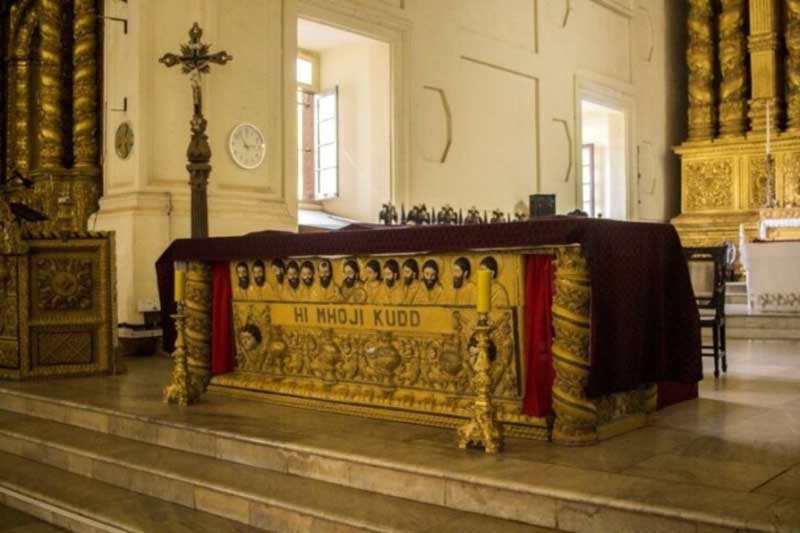
The Basilica of Bom Jesus, the oldest church in Goa, located in Bainguinim, about 10 km away from Panjim, has the distinction of holding the mortal remains of St. Francis Xavier. Constructed in 1594 and consecrated in 1605, the building of the church, known for its exemplary baroque architecture, coincides with the beginning of Christianity in India. The Basilica of Bom Jesus, which literally stands for the Basilica of Holy Jesus, and considered to be one of the best examples of Portuguese Colonial architecture in India, is the only church in Old Goa, which is without any protective or decorative cover of plaster on the outside. Instead, its façade has triangular roofing, delicately carved with the capital letters IHS, the abbreviation for Jesuit emblem meaning Jesus Saviour of Men.

The Basilica of Bom Jesus in Goa, built by the Jesuit missionary order, was designed as a part of the residential buildings for the priests and was not funded by the Portuguese crown, unlike the Sé Catedral de Santa Catarina, also located in Old Goa. Probably, mainly due to that reason and the eventually limited funding, the building of the Basilica of Bom Jesus is comparatively modest than the other churches built in the vicinity at that time.
This is clearly evident in the outstanding stone barrel vault roof and the impressive lateral chapels found both in the Sé Catedral and the ruined Church of St. Augustine of Old Goa. However, despite the overall modest design, and the use of local laterite stone in its construction, the use of Bassein basalt in the front façade completely changed the picture and gave the basilica a dignified look. The three bays, dividing the façade vertically and horizontally, are made of laterite, but plastered and whitewashed, unlike the rest of the basilica.

The three storey building of the Basilica of Bom Jesus, reflecting Ionic, Doric, and Corinthian orders and measuring 183 feet in length, 55 feet in width, and 61 feet in height, has its main entrance flanked by two smaller ones, each having Corinthian columns supporting a pediment. The church is cruciform in plan, and its marble floor is inlaid with precious stones.
It is equipped with a choir above the main entrance, a single nave or main hall measuring 164 feet by 75 feet (50 m by 23 m), along with the main chapel at the end, and a sacristy, a chamber where the priests get ready for the service and where the vestments and the items of worship are stored.


While the altar of St. Anthony lies to the right side of the nave, the left side is decorated with a meticulously carved wooden statue of St. Francisco Xavier. There is a cenotaph near the northern wall, dedicated to Dom Jeronimo Mascarenhas, the benefactor of the church and the Captain of Cochin, facing an intricately carved wooden pulpit with figures of Jesus engraved on its three sides, and a canopy on its top. The bottom of the pulpit has seven figures, as if supporting the structure.
The elaborately gilded main altar holds a big gilded statue of St. Ignatius of Loyola, the founder of the Jesuits Society and one of the companions of Francis Xavier, gazing upwards at a figure of baby Jesus, and above a medallion, the gilded emblem of the Jesuits encircled with radiant rays. The main altar is flanked by two other decorated altars dedicated to Our Lady of Hope and St. Michael.

However, the highlight of the Basilica of Bom Jesus is the tomb of St. Francisco Xavier, located in a chapel with twisted columns and dedicated to him. The mausoleum, designed by the distinguished Florentine sculptor Giovanni Battista Foggini in 1686, was a gift to the basilica by the Duke of Tuscany, Cosimo III, last of the Medicis. An exquisitely carved silver casket that was once studded with precious stones contains the remains of St. Francis Xavier. The sides of the casket are engraved with reliefs, depicting several important incidents in the life of the saint.

Apart from being the first minor basilica in India and one of the Seven Wonders of Portuguese Origin in the world, the Basilica of Bom Jesus is a symbol of Goan identity. Due to the huge popularity of St. Francisco Xavier, the influential Goan patrons, like the viceroys and governors of Portuguese India, along with the high-ranking political and military dignitaries, became attached to the basilica. As it had the patronage of those influential persons, the age-old basilica survived, despite the sad deterioration of the many other important structures of Old Goa. In return for their investment in protecting the architectural legacy of the building, they were honoured with burials in the church. Thus, although basically a repository of an architectural history of Portuguese India, the Basilica of Bom Jesus in Goa also stands as a symbol of the Jesuit order, the legacy of St, Xavier as well as the several individuals who were attached to it.